From afar, the aesthetic value of trees can be perceived through their height, the way their branches grow, their flowers, and, mostly, the color of their leaves.
But if you take a closer look, you will notice a few other things that you might have missed, such as their leaf shapes.
In fact, not all tree leaves have similar shapes or appearances. Some species have broad leaves that are covered with waxy cuticles, while others are pinnate or needle-like.
There are also trees with beautiful heart-shaped leaves that might appeal to your heart and could make a great addition to your garden and front lawn.
In this article, we have compiled some of the best tree species that produce heart-shaped leaves. With that said, let’s dive in deeper and take a look at each of them.
Table of Contents
1. Empress Tree (Paulownia tomentosa)

Empress trees are native to eastern Asia, specifically in western and central China. But they can also be found in North America, the eastern part of the United States, and Western and Central Europe.
Empress trees are also called foxglove trees and princess trees. These deciduous trees received their name from one Russian princess, Anna Pavlovna, as a way to honor and commemorate her.
Empress trees typically grow between 20 and 50 feet, with a spread around 30 feet wide. They have large, soft, heart-shaped, green leaves and fragrant lavender flowers that bloom in the spring.
These trees thrive in USDA hardiness zones 5 to 9.
They tend to grow healthier in wet and slightly acidic soil with proper drainage. They can also tolerate partial sun or shade but love to stay under full sun.
2. Henry’s Lime (Tilia henryana)

These small to medium-sized deciduous trees originated from China.
They were named after an Irish nurseryman, Augustine Henry, who discovered these trees in 1888. In the early 1900s, they were introduced to the West by a man named Ernest Wilson before they were commercially cultivated and dispersed to other regions.
Henry’s lime trees generally grow between 20 and 30 feet tall with almost the same width. At most, they can grow up to 80 feet tall.
These trees possess heart-shaped green leaves with teeth-like structures around the edges of the leaves, slender brown bark, and whitish or creamy yellow flowers that bloom from late summer to early autumn.
Henry’s lime trees thrive in USDA hardiness zones 6 to 8. They can tolerate partial or full sun and love moist, well-drained, and slightly alkaline soil.
3. Silver Linden (Tilia tomentosa)
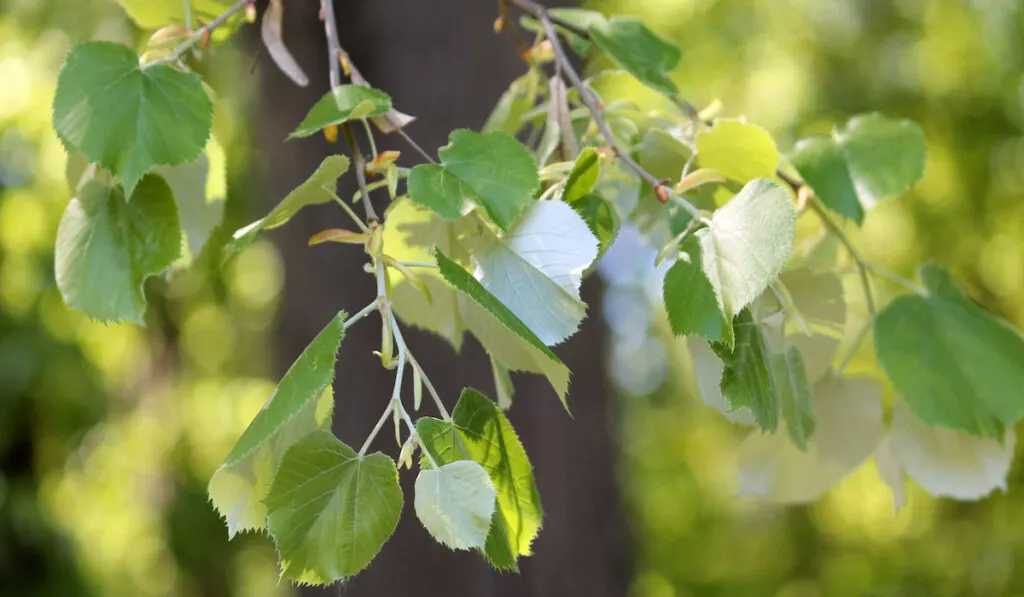
Silver linden trees are also known as silver lime trees and European white lime trees. They grow in abundance in Europe, southwestern Asia, and western Turkey.
In 1767, these trees were introduced into the United States and were primarily grown as ornamental trees.
Silver linden trees have smooth brown bark, silvery green heart-shaped leaves that turn yellow when fall comes, and light-yellow flowers that bloom in the early summer.
These medium to large-sized deciduous trees typically grow between 50 and 70 feet tall with a spread between 40 and 60 feet wide.
Silver lindens thrive in the USDA hardiness zones 4 to 7 and are highly resistant to hot environments, dry seasons, strong wind, and even frost.
4. Northern Catalpa (Catalpa speciosa)

These medium to large-sized deciduous trees are native to the midwestern United States. They are also known as the catawba, western Catalpa, cigar tree, and hardy catalpa.
Northern catalpas generally grow between 40 and 70 feet and spread between 20 and 40 feet wide. In the United States, the largest northern catalpa grows in Indiana, standing tall at around 85 feet.
These trees can be recognized by their reddish brown to grayish brown bark, large, heart-shaped green leaves, and upright panicles of bell-shaped white flowers that bloom from the late spring until early summer.
Northern Catalpas thrive in USDA hardiness zones 4 to 8 with high tolerance to different types of soil. They can also deal with partial or full sun and even dry environments efficiently.
5. White Mulberry (Morus alba)

White mulberry trees are native to northern China and India.
Back in the booming era of the silk industry, they were introduced into the United States to be grown as a source of food for silkworms. This is where they got the name “silkworm mulberry.”
These small to medium-sized deciduous trees have grayish brown bark, sweet, honey-like white fruits, white flowers that bloom in the spring, and glossy green leaves that come in different shapes, such as heart-shaped, regular and irregularly lobed, and jagged edges.
White mulberry trees generally grow between 40 and 60 feet tall, with a spread between 20 and 40 feet wide.
They are suitable to be grown in USDA hardiness zones 3 to 9, with enough exposure to partial or full sun.
These trees can also adapt to soils with different pH levels. But still, they prefer moist, neutral pH, and well-drained soil. On average, white mulberry trees can live between 30 and 50 years, even up to 75 years.
6. Quaking Aspen (Populus tremuloides)
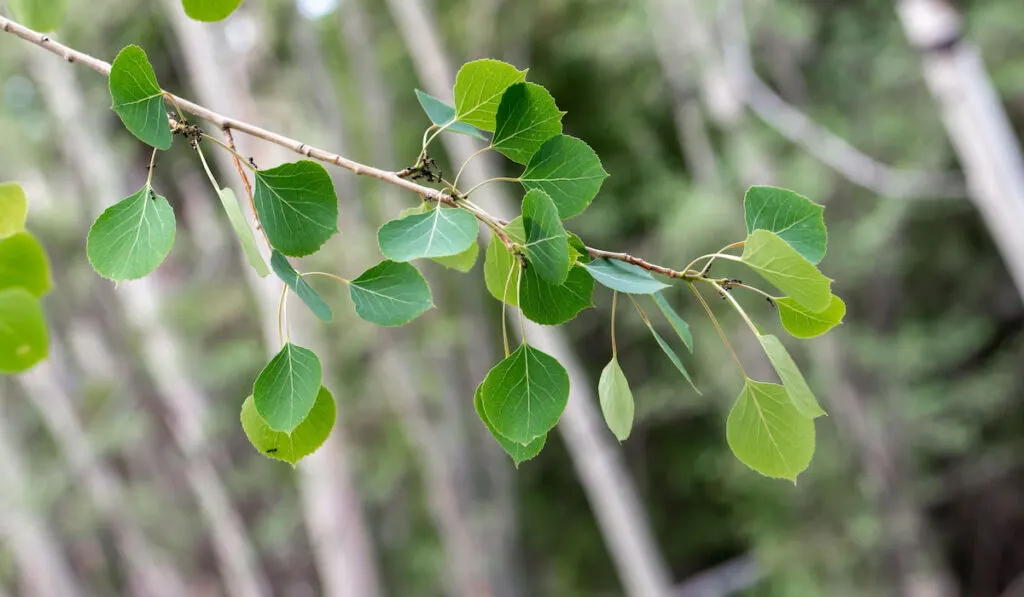
These large and towering trees are native to North America. They are also called trembling aspens, popples, white poplars, golden aspens, and mountain aspens.
Quaking aspens generally grow between 20 and 50 feet tall, with a spread between 20 and 30 feet wide. At maturity, they could even grow up to 70 feet tall.
These medium to large-sized deciduous trees have whitish-gray bark, yellowish-green heart-shaped leaves, and dark green flowers that turn red or yellow when fall comes.
Quaking aspens thrive in the USDA hardiness zones 1 to 6. They need full sun and love moist soil with proper drainage. At most, these trees could live between 150 and 200 years.
7. Italian Alder (Alnus cordata)
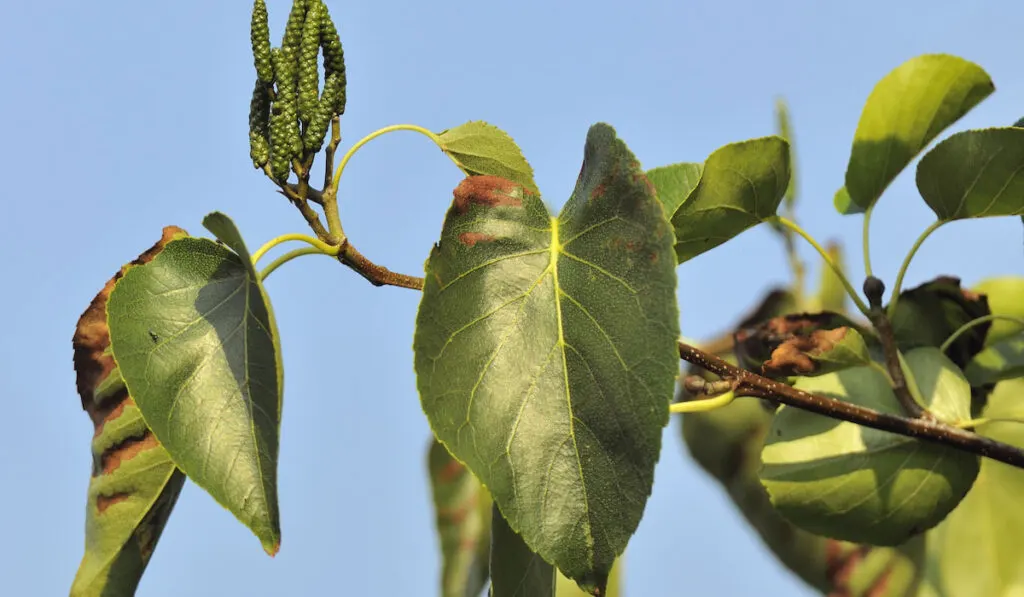
Italian alder trees originated from southern Italy and certain regions in Greece. These medium-sized trees typically grow between 20 and 80 feet tall, with a spread between 30 to 40 feet wide.
They can be recognized by their smooth gray bark, yellowish to reddish brown flowers that bloom in the spring, and glossy, heart-shaped green leaves that turn golden or brown when fall comes.
You can grow Italian alder trees in USDA hardiness zone 5 to 7. As long as the soil is moist and well-drained, they don’t mind dealing with changing pH levels in the soil.
You can plant these trees in parks or front yards due to their strength and resistance to wind. Their thick foliage can also provide enough shade for the surrounding environment while indirectly helping in regulating the increase of natural heat.
8. Yellow Catalpa (Catalpa ovata)

These small to medium-sized deciduous trees are native to western China. They are also known as Chinese catalpas and Japanese catalpas.
Yellow catalpas have grayish brown bark, large lobed and heart-shaped green leaves, and yellowish-white flowers that bloom in the late spring.
These trees generally grow between 20 and 30 feet, with a spread around 20 feet wide.
Their flowers that resemble orchids will attract pollinators such as bees and butterflies, especially during their flowering period from July to August.
Like most deciduous trees, yellow catalpas prefer to have full sun exposure and grow in moist, well-drained soil.
Due to the large size of their foliage, these trees are suitable to be planted as ornamental trees or shade trees at the park.
9. Turkish Filbert Hazel (Corylus colurna)
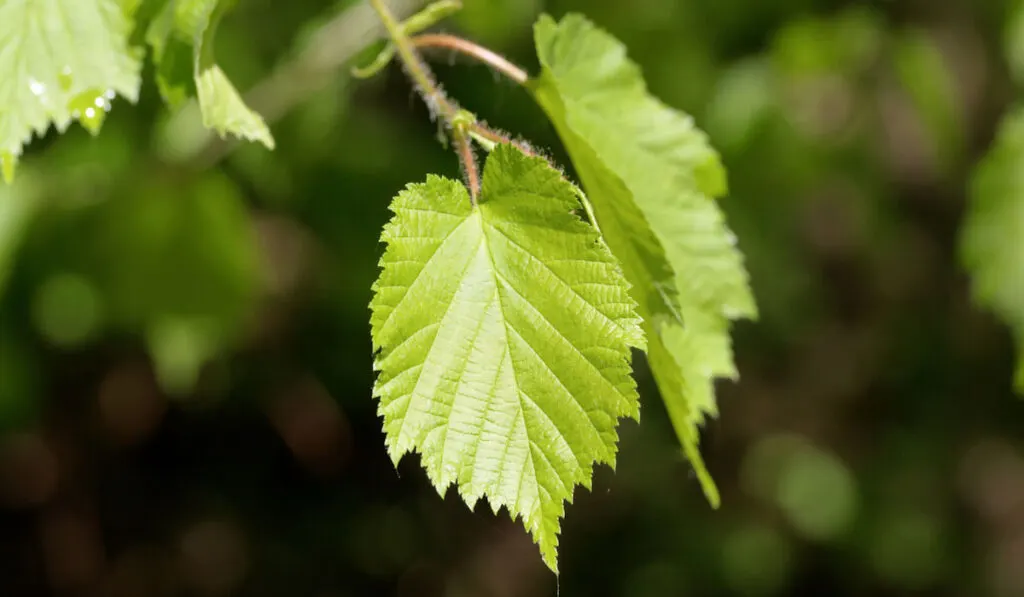
Turkish filbert hazels or Turkish hazels are native to regions in southeast Europe and west Asia.
These medium to large-sized deciduous trees have smooth, grayish brown bark, green heart-shaped leaves, and light-yellow flowers that bloom in the early spring.
Turkish hazels also produce nuts that are much smaller than the common hazelnut. Turkish hazels usually grow between 40 and 50 feet tall with a spread between 30 and 40 feet wide.
These trees thrive in USDA hardiness zones 4 to 7. They can tolerate partial or full sun and prefer moist and well-drained soil.
Being a hardy species, you can grow these trees as ornamental and shade trees for front yards and recreational parks.
10. Caucasian Lime (Tilia x euchlora)
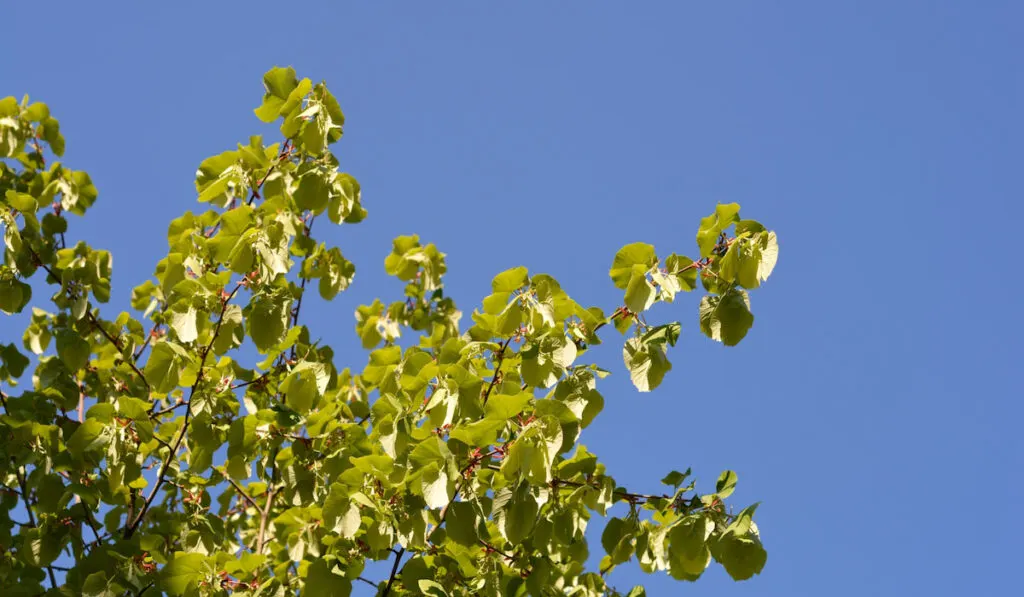
Also known as the Crimean lime and Caucasian linden, these large deciduous trees originated from the Crimean peninsula near Ukraine.
Caucasian lime trees were produced from a cross between two different species, Tilia dasystyla and Tilia cordata.
These trees typically grow between 40 and 60 feet tall and spread between 20 and 30 feet wide. They possess glossy, heart-shaped leaves and white to creamy flowers that bloom in the spring until summer.
Caucasian lime trees can tolerate partial or full sun. However, they grow healthily in moist, well-drained soil and in USDA hardiness zones 3 to 8.
Like many deciduous trees, you can definitely plant these trees to provide shade for your house and surrounding property.
11. Eastern Redbud (Cercis canadensis)
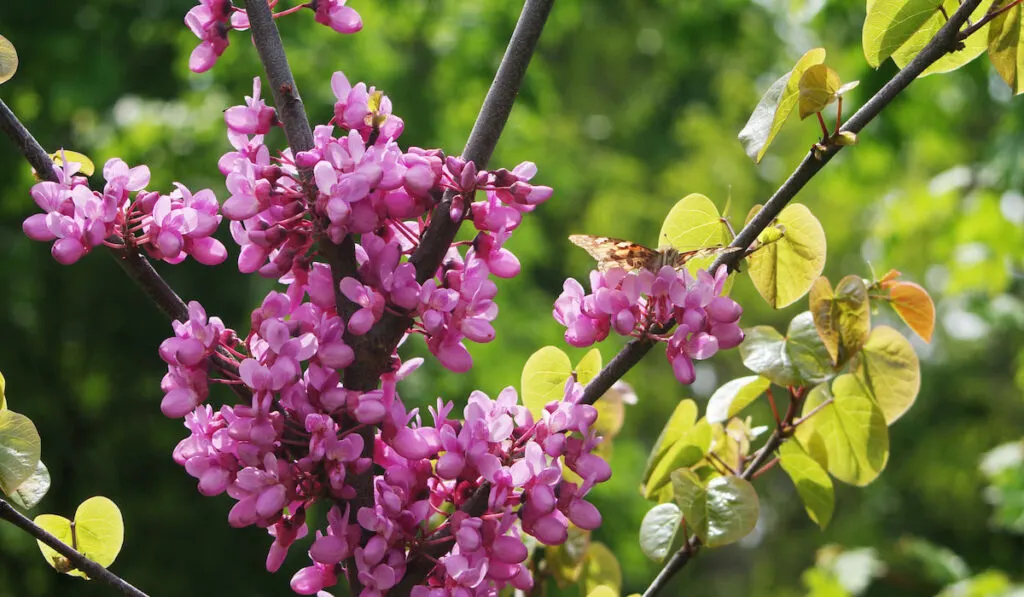
Eastern redbud trees are native to North America, particularly from west Oklahoma to New Jersey, southern Michigan, and central Mexico.
These medium to large-sized deciduous trees have multi-trunk shape, reddish brown bark, green heart-shaped leaves, and whitish purple or pink five-petaled flowers that bloom in the spring.
Eastern redbud trees typically grow between 20 and 30 feet tall and spread between 25 and 35 feet wide.
These trees thrive in USDA hardiness zones 4 to 9. They can be grown under partial or full sun, but they prefer moist, well-drained soils.
12. Southern Catalpa (Catalpa bignonioides)

These medium-sized deciduous trees originated from the southeast part of the United States, particularly in Florida, Georgia, Alabama, and Louisiana. They are also known as Indian bean trees or cigar trees.
Southern catalpas usually grow between 30 and 60 feet tall, with a spread between 20 and 40 feet wide.
Southern catalpas have thick brown bark, glossy green heart-shaped leaves, and scented, trumpet-like white flowers that bloom in the late spring.
These trees thrive in USDA hardiness zones 5 to 9 and can tolerate soils with different pH levels. However, like most deciduous trees, they still prefer moist and well-drained medium to grow in. They can tolerate partial or full sun.
13. American Lime (Tilia americana)
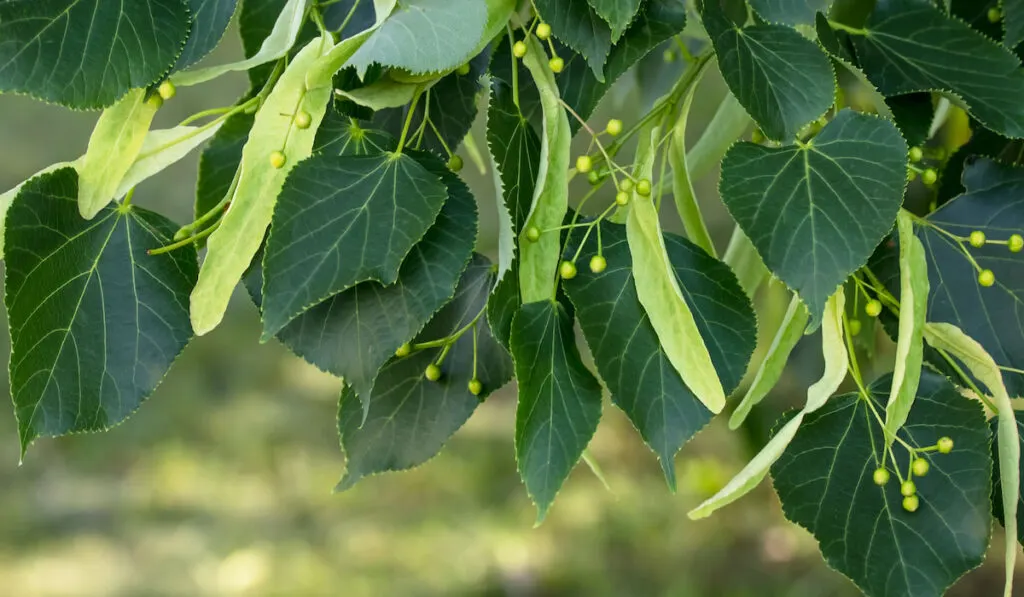
American lime trees are native to eastern and central North America. They are also called American linden trees or basswood.
These medium to large-sized deciduous trees typically grow between 50 and 80 feet tall and spread between 30 and 50 feet wide.
American lime trees possess grayish brown bark, glossy dark green heart-shaped leaves that turn yellowish in the fall, and whitish-cream scented flowers that bloom in the spring.
These trees thrive in USDA hardiness zones 2 to 8 and can tolerate partial or full sun. Although they have a high tolerance for acidity changes in the soil, they grow best in moist and well-drained soil.
American lime trees also attract pollinators such as birds and butterflies.
14. Large-Leaved Lime (Tilia platyphyllos)

These medium to large-sized deciduous trees can be found abundantly in their native habitats, such as Europe and southwestern Asia. Growing between 60 and 80 feet tall, with a spread between 30 and 50 feet wide, they are definitely a good candidate for shade plants.
Large-leaved lime trees are also known as large-leaved lindens. These trees have thick brown bark, dark green heart-shaped leaves that turn yellow when fall comes, and whitish yellow scented flowers that attract insect pollinators such as butterflies.
Being a hardy species, large-leaved limes are considered low maintenance and thrive in USDA hardiness zones 2 to 6.
Large-leaved lime trees can tolerate partial or full sun. They also prefer moist and well-drained soil.
15. Katsura Tree (Cercidiphyllum japonicum)

Katsura trees are native to Asia, specifically Japan and China. They are also called Japanese Judas trees.
These large-sized deciduous trees often have a multi-trunked structure with brown bark, tiny red flowers that bloom in the spring, and large heart-shaped green leaves that turn different colors such as reddish-purple, greenish blue, coppery gold, and reddish brown, according to seasonal changes.
Due to the caramel and burnt sugar scent that they produce when the leaves decay in fall, they are also known as caramel trees.
Katsura trees typically grow between 40 and 50 feet tall and spread between 25 and 35 feet wide.
They thrive in USDA hardiness zones 4 to 8 and can tolerate partial or full sun. These trees also prefer slightly acidic, moist, and well-drained soil.
Final Thoughts
Although all the trees listed above share the same leaf shape, they don’t exactly grow the same way or need the same environment to thrive and survive. There are many factors that differentiate one species from another.
Some species need to be exposed to sunlight for many hours, while others can tolerate cold seasons and wet environments. Hence, if you’re looking to grow any species from this list, always choose the one that can adapt to your local climate.
Resources
- https://plants.ces.ncsu.edu/plants/paulownia-tomentosa/
- https://www.gardenia.net/plant/tilia-henryana
- https://www.vdberk.com/trees/tilia-tomentosa/
- https://landscapeplants.oregonstate.edu/plants/catalpa-speciosa
- https://sites.redlands.edu/trees/species-accounts/whitemulberry/
- https://www.fs.fed.us/wildflowers/beauty/aspen/grow.shtml
- https://www.vdberk.co.uk/trees/alnus-cordata/
- https://www.vdberk.com/trees/catalpa-ovata/
- https://campustrees.umn.edu/turkish-hazel
- https://www.gardenia.net/plant/tilia-x-euchlora
- https://www.gardendesign.com/trees/eastern-redbud.html
- https://www.gardenia.net/plant/catalpa-bignonioides
- https://www.gardenia.net/plant/tilia-americana
- https://www.gardenia.net/plant/tilia-platyphyllos
- https://www.gardenia.net/plant/cercidiphyllum-japonicum-katsura-tree
- https://www.keele.ac.uk/arboretum/ourtrees/speciesaccounts/henryslime/
- https://wp.towson.edu/glenarboretum/home/northern-catalpa/
